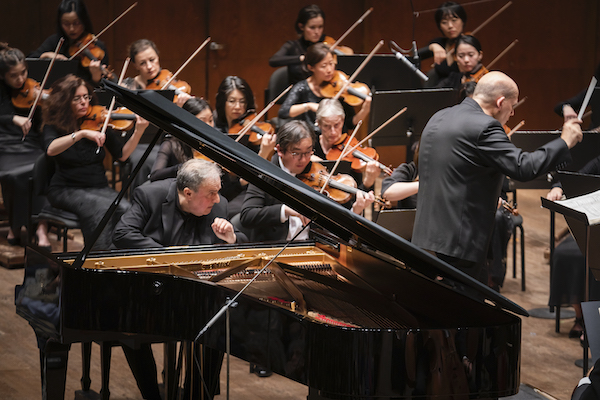Philharmonic outing offers problematic Reich, brilliant Bronfman

After 35 years, Steve Reich was ready for the New York Philharmonic. But was the New York Philharmonic ready for Steve Reich?
Thursday’s performance of Reich’s Music for Ensemble and Orchestra, the eagerly-awaited local premiere of the composer’s first work for large orchestra in decades, had surprisingly little impact, despite a strong overall concept and an abundance of fresh musical ideas.
In his orchestral re-debut, Reich tipped his trademark baseball cap to predecessors as diverse as J.S. Bach and Béla Bartók, easing into the symphonic scene with a 20-minute concerto grosso featuring his familiar ensemble of strings, winds and percussion accompanied by a string orchestra (with trumpets), and ordering the music in the five-movement arch form favored by the Hungarian master.
Although driven throughout by a steady tick-tick-tick of keyboard chords, the new piece favored more open textures and more melodious motives than usual for this composer. Without varying the underlying beat, Reich created different perceived tempos by changing the prevailing note values from 16ths to eighths to quarters and back again.
For long stretches, the scoring was as minimal as the composing style was minimalist. At the same time, there was no lack of Reichian close imitation, particularly in the featured ensemble.
The audience’s response afterward was brief and tepid, although it swelled to cheers when conductor Jaap van Zweden virtually pushed the shy composer onstage—an acknowledgement of how the 83-year-old Reich, along with Philip Glass and John Adams, has made minimalism the soundtrack for contemporary life.
And on the evidence of this score and the one for the interdisciplinary work Reich Richter Pärt, presented last spring at The Shed, this composer’s command of his rich idiom hasn’t slackened at all.
Certainly Thursday’s long, rectangular performing space was no friend to such intricately worked music. Just three days before, the Philharmonic and Lincoln Center had announced the latest reconstruction plan for Philharmonic/Fisher/Geffen Hall, which has had even more acoustic makeovers than name changes.
But the faint impression left by the piece Thursday must be laid mainly at the door of conductor van Zweden and the Philharmonic.
After disappointing experiences with performances of his music by symphony orchestras in the 1980s, Reich had retreated to his own hand-picked ensemble. A couple of years ago, a new generation of orchestral musicians steeped in the minimalist idiom—plus a commission from six orchestras including the Philharmonic—had lured him back.
In this case, his confidence may have been misplaced. Coming off a slack, offhand performance of Beethoven’s Symphony No. 2 moments before, the orchestra seemed unable to muster the energy and precision to do justice to Reich’s score. Execution seemed bland and dutiful, where a jazzier, more Bernsteinian attack would have highlighted Reich’s rhythmic interplay. At least the crisp playing of digital keyboards and vibraphones helped hold it together.
From a distance, one could appreciate the many virtues of the new piece: the layering of instrumental colors, the Bachian building up and thinning out, and special effects such as, near the end, the warble of wind instruments going in and out of phase with each other. (One hopes that was deliberate.) The work has had several outings now from its various commissioners, and one hopes for many more.
As mentioned, Reich’s piece was preceded on the program by a performance that seemed to relegate Beethoven’s Second Symphony to the status of throwaway curtain-raiser. Even curtain-raisers deserve better than the careless rhythms and fuzzy attacks, the speeding up when the note values get longer, the mezzo-forte default dynamic, and other signs of inattention that plagued all four movements.
It was pianist Yefim Bronfman to the rescue in the concert’s second half, bringing impeccable musicianship and vitality to Beethoven’s Piano Concerto No. 4. After a first-movement exposition in which the orchestra carelessly shortened all the long notes, Bronfman corrected the rhythm in his solo, and his colleagues’ playing shaped up after that, although a tendency to rush was ever-present in the orchestral tutti.
Under Bronfman’s hands, the movement’s onrushing triplet 16ths were sparkly or buttery as the music demanded, whether in a pianissimo breeze or a fortissimo blaze. Beethoven’s extravagant solo cadenza was expertly paced, by turns singing, ornate, whimsical, and roaring.
Pianist and conductor took the Andante’s contrast between brusque strings and quiet piano to its extreme, the pianist playing almost tonelessly. It was Orpheus (in the commonly-cited metaphor for this movement) not so much charming the Furies as making them as depressed as he was.
Into that gray space stole an effervescent theme, pianissimo, and a crisply-played finale followed, with the pianist expertly shaping his part and guiding transitions and the overall flow. Following Beethoven’s fanciful, dazzling, amorous cadenza, pianist and orchestra romped to the finish, together and in time, a good way to end a perplexing night.
The program will be repeated 8 p.m. Saturday. nyphil.org; 212-875-5656.